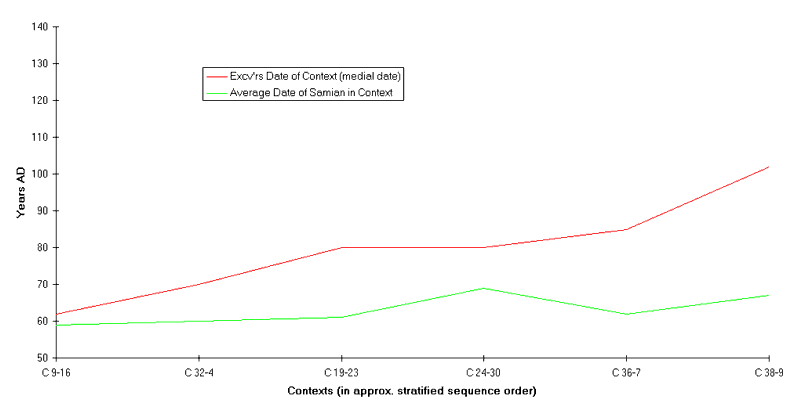Data collected for Phase 1 of this Project had suggested that the conventional dating of the well known decorated bowl form Drag. 29 was in need of review (Willis 1998a, Illus. 11), and this is sustained by Phase 2 of this study. This South Gaulish form, by convention, is perceived as becoming residual from c. AD 85 (cf. Webster 1996, 40-1; cf. Table 5, this study). However, the evidence of the stratified incidence of this type suggests that even though the type may have been passing out of production by c. AD 85 its frequency within deposits remained comparatively strong into and through the Trajanic period to c. AD 125. Whilst a proportion of items will represent residual pieces the percentage frequency is sufficiently high to firmly suggest that vessels of this form were continuing in currency and circulation during this period, indicating their curation at a significant number of sites a least. This clear discrepancy between the conventional dating and that indicated by the database raised questions which where discussed elsewhere (Willis 1998a, 103-4) and which are taken up below (Section 5.8).
Drag. 29 vessels seemingly remained in use longer at civil sites than at military sites (cf. Willis 1998a; cf. Table 6, this study). It was noted in the 1998 paper that if units of the Roman army received fresh supplies of samian on a fairly regular basis, assemblages from such sites will appear more 'up-to-date' than at non-military sites (eg. London) where some quantity of older vessels continued to be current. The question of different rates of samian turnover at different types of site is an interesting field for study with important ramifications for studies of the Roman period. Differential rates of turnover at different site types is a phenomenon which presumably extends to other artefact classes. In terms of samian ware this phenomenon warrants investigation and is examined further below (Section 5.8).

Chart 9:
Comparison of the Date of Deposits, with the Average Date of the Samian Recovered from those Deposits: Southwark, The Bonded Warehouse, Montague Close, 1974. (Data: SLAEC 1978).
In the report upon the excavations at Southwark, 93-5 Borough High Street, 1974, Orton looked at the relationship between the date of sherds and the estimated date of their context (1978, 460-1; cf. Millett 1987a; 1987b; Wallace forthcoming). A slightly different method is used to show this relationship here, as a heuristic device (Charts 9 and 10 below). Two assemblages were examined: The Bonded Warehouse, Montague Close, 1974, and 93-5 Borough High Street, 1974, both in Southwark (Table 8 and Table 9). The data confirm an increasing divergence between the excavators' date of the deposit/horizon and that suggested by the average date of the samian pottery present. Residuality is likely to be one factor in such cases. Generally dating of layers using samian comes to rely on proportionally less of the samian sherds present with time. This may not be the 'latest' samian sherd/s (cf. Millett 1987a) nor the date range of the bulk of sherds, but perhaps relies upon the date of several of the latest sherds.

Chart 10:
Comparison of the Date of Deposits, with the Average Date of the Samian Recovered from those Deposits: Southwark, 93-5 Borough High Street, 1974. (Data: SLAEC 1978).
© Internet Archaeology
URL: http://intarch.ac.uk/journal/issue17/1/5.5_6.html
Last updated: Mon Mar 7 2005